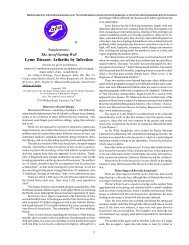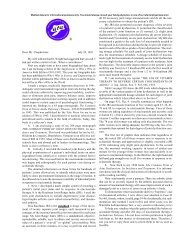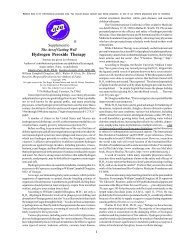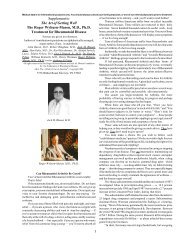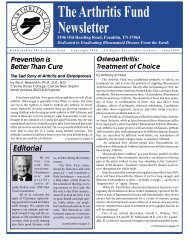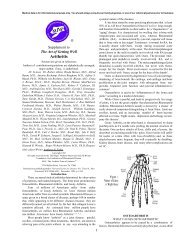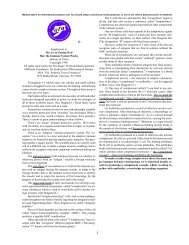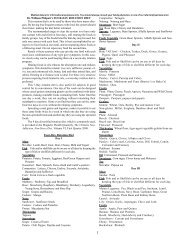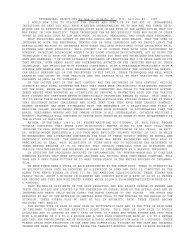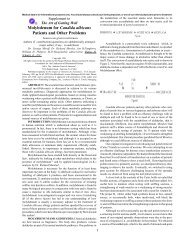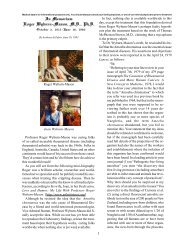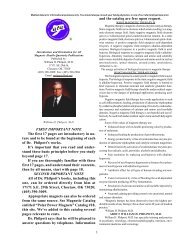Mycoplasmas Properties and Their Role in Autoimmune Diseases
Mycoplasmas Properties and Their Role in Autoimmune Diseases
Mycoplasmas Properties and Their Role in Autoimmune Diseases
You also want an ePaper? Increase the reach of your titles
YUMPU automatically turns print PDFs into web optimized ePapers that Google loves.
Medical data is for <strong>in</strong>formational purposes only. You should always consult your family physician, or one of our referral physicians prior to treatment.isolates were referred to as Pleuropneumonia-Like Organisms(PPLO), now known as <strong>Mycoplasmas</strong> <strong>in</strong> the broader Mollecutesfamily.The terms PPLO <strong>and</strong> wall-less bacteria L-forms were used<strong>in</strong>terchangeably until 1962 when a viral-like agent caus<strong>in</strong>gatypical pneumonia but sensitive to tetracycl<strong>in</strong>e <strong>and</strong> cultured <strong>in</strong> acell-free media was found to be a new human mycoplasma stra<strong>in</strong>(M. pneumoniae). Because of the <strong>in</strong>creas<strong>in</strong>g number of stra<strong>in</strong>s,®PPLO were classified under bacterial Mollecutes with theSan Marcos University College of Veter<strong>in</strong>arian Medic<strong>in</strong>e mycoplasmatacae family <strong>and</strong> subspecies mycoplasma <strong>and</strong>Lima, Peru Lectures 8/99ureaplasma. Our modern day culture techniques have improvedby Harold W. Clark, Ph.D.over the early technique of implant<strong>in</strong>g a cellophane bag with theMycoplasma Research Institute, PO Box 640040, Beverly Hills, specimen <strong>in</strong> a rabbit’s abdomen. The difficulties <strong>in</strong> isolat<strong>in</strong>gFL 34464-0040; E-mail: www.hwcmri@hitter.net mycoplasmas from <strong>in</strong>flamed tissues still rema<strong>in</strong>s.All rights reserved by the The Roger Wyburn-Mason <strong>and</strong> Jack M.BlountS<strong>in</strong>ce their first isolation, a major impediment to mycoplasmaFoundation for Eradication of Rheumatoid Diseaseresearch <strong>and</strong> laboratory diagnosis of <strong>in</strong>fection has been theAKA The Arthritis Trust of America ®difficulty of isolat<strong>in</strong>g mycoplasmas from the host tissues. To7376 Walker Road, Fairview, TN 37062overcome this problem complex cell-free media are used for bothwww.arthritistrust.orgisolation <strong>and</strong> cultivation. The media is usually based on beef heart<strong>in</strong>fusion, peptone digest, yeast extract, serum <strong>and</strong> varioussupplements. The cont<strong>in</strong>ued use of these complex undef<strong>in</strong>edmedia components has limited the precise def<strong>in</strong>ition ofmycoplasma’s metabolic pathways, genetic analysis, preparationof mycoplasma antigens free of media components <strong>and</strong> specificmonoclonal antiserum free of endogenous antibodies. The abilityto detect <strong>and</strong> identify mycoplasmas <strong>in</strong> tissues us<strong>in</strong>g the geneticPolymerase Cha<strong>in</strong> Reaction (PCR) technique should be measured<strong>in</strong> relation to the host’s immunologic <strong>and</strong> other responses to an<strong>in</strong>fection. In addition there is some concern about the adaptation ofnew mycoplasma isolates be<strong>in</strong>g changed when grown <strong>in</strong> artificialmedia <strong>and</strong> subjected to viruses.The first question we should ask <strong>and</strong> def<strong>in</strong>e is “What areHarold W. Clark, Ph.D.<strong>Mycoplasmas</strong>?” And what are their connections with humanarthritis especially the chronic rheumatic diseases of unknownLecture I: <strong>Mycoplasmas</strong> <strong>Properties</strong> <strong>and</strong>orig<strong>in</strong>. If mycoplasmas are now known to cause arthritis <strong>in</strong> animalstheir <strong>Role</strong> <strong>in</strong> <strong>Autoimmune</strong> <strong>Diseases</strong>as well as acute <strong>and</strong> chronic disease <strong>in</strong> human lungs <strong>and</strong> theThank you for <strong>in</strong>vit<strong>in</strong>g me to lecture on Mycoplasma Arthritisgenitour<strong>in</strong>ary tract their location <strong>in</strong> human jo<strong>in</strong>ts could also be the<strong>in</strong> humans.irritant caus<strong>in</strong>g <strong>in</strong>flammation. Thus we have mixed tissue arthritisToday I will review “<strong>Mycoplasmas</strong> <strong>Properties</strong> <strong>and</strong> their <strong>Role</strong>with a comb<strong>in</strong>ation of symptoms. Mixed arthritis is further<strong>in</strong> <strong>Autoimmune</strong> <strong>Diseases</strong>,” by Harold W. Clark, PhDcomplicated by add<strong>in</strong>g another vague term “RheumatoidIn 1952 when I jo<strong>in</strong>ed Dr. Thomas McPherson Brown, chiefArthritis” (RA). Accord<strong>in</strong>g to the U.S. Arthritis Foundation, theof medic<strong>in</strong>e at the George Wash<strong>in</strong>gton Univ. Medical School <strong>in</strong>whole group of Rheumatic <strong>Diseases</strong> now constitutes 171 types ofWash<strong>in</strong>gton, D.C, as Research Biochemist, the chief of medic<strong>in</strong>e atarthritis with associated diagnoses <strong>and</strong> mixtures of symptoms.the University of Rochester <strong>in</strong> New York told me that Dr. BrownThese <strong>in</strong>clude mycoplasma arthritis, connective tissue diseases,has a theory that some atypical microbe was the cause of<strong>and</strong> mixed connective tissue diseases. RA was <strong>in</strong>itially calledRheumatoid Arthritis that should be treated with antibiotics.Chronic Infectious Arthritis, when it was first thought to be causedUnknown to me, the year before, 1951, Dr. Brown <strong>and</strong> staff had justby some atypical viral-like agent <strong>and</strong> is now referred to aspublished <strong>and</strong> reported at the International Arthritis meet<strong>in</strong>g their<strong>Autoimmune</strong> disease, Immune Complex disorders, <strong>and</strong> Collagenrecent f<strong>in</strong>d<strong>in</strong>gs entitled “A Study of the Antigen-AntibodyVascular disorders. The diagnostic term<strong>in</strong>ology is more confus<strong>in</strong>gMechanism <strong>in</strong> Rheumatoid <strong>Diseases</strong>”. This report emphasized thewhen based on the symptoms, the tissue targeted, the diseaseantibiotic treatment of rheumatoid diseases based on the suspectedmechanisms, <strong>and</strong> the microbial causes. This term<strong>in</strong>ology <strong>in</strong>cludesmycoplasma role <strong>in</strong> the <strong>in</strong>flammatory immune complex thatseptic, reactive or <strong>in</strong>fectious, bacterial, viral, Lyme, <strong>and</strong>should be blocked by immunosuppres<strong>in</strong>g agents.mycoplasma arthritis <strong>in</strong> humans. The mixed symptoms caused byBecause of its potential application the report was widelymycoplasmas are not the same as caused by bacteria <strong>and</strong> viruses.publicized <strong>in</strong> newspapers <strong>and</strong> magaz<strong>in</strong>es. For example theThe different responses are attributed to mycoplasma’s differentAssociated Press reported “Hope Held out for Cure of Rheumaticphysical, chemical <strong>and</strong> host related properties.Ills, Wash<strong>in</strong>gton research team announces New Concept on CausesWhat is Mycoplasma Arthritis?<strong>and</strong> Cures”. At that time except for the veter<strong>in</strong>arians, very fewThe common symptom <strong>in</strong> most Rheumatic <strong>Diseases</strong> isdoctors knew what a PPLO or mycoplasma was, let alone its role <strong>in</strong><strong>in</strong>flammation as anatomically described by synovitis, bursitis,human arthritis.carditis, neuritis, or nephritis, etc. Many different causes ofAlthough Koch <strong>and</strong> Pasteur had brought bacteria to the<strong>in</strong>flammation have been suggested <strong>and</strong> pursued. Upon furtherforefront of medic<strong>in</strong>e it was the microbiologists Nocard <strong>and</strong> Rouxstudy <strong>and</strong> review, researchers may f<strong>in</strong>d that a common microbe,at the Pasteur Institute <strong>in</strong> 1898 that first isolated a filtrable bacteriasuch as <strong>Mycoplasmas</strong> can cause various host responses orfrom pneumonic <strong>and</strong> arthritic cattle. For the next 65 years new1
Medical data is for <strong>in</strong>formational purposes only. You should always consult your family physician, or one of our referral physicians prior to treatment.symptoms <strong>in</strong> similar tissues. Because of the different portals ofentry differences between <strong>in</strong>dividuals may be observed. Because ofthe associative factors; age, gender, genetics, <strong>and</strong> environment amicroorganism could cause arthritis <strong>in</strong> one patient, systemic lupuserythematosus (SLE) <strong>in</strong> another, or neither disorder. The sameagent <strong>and</strong> mechanism that causes <strong>in</strong>flammation of the synovialtissues <strong>in</strong> a male patient may cause nephritis or both <strong>in</strong> a female. As<strong>in</strong> Juvenile Rheumatoid Arthritis, the juvenile host could responddifferently to mycoplasmas than a mature host. <strong>Mycoplasmas</strong>could <strong>in</strong>fect the fetus <strong>and</strong> lay dormant until challenged <strong>and</strong> latercould cause different symptoms.Of all the targeted organs <strong>and</strong> tissues, the blood supply is trulyour lifel<strong>in</strong>e <strong>and</strong> first l<strong>in</strong>e of defense that controls the severity <strong>and</strong>spread of viable agents. The blood supply may determ<strong>in</strong>e theprimary site of disease activity, such as the kidney or liver, orsynovium, <strong>and</strong> whether it is localized or widespread. Some targetedtissues such as the synovium, eyes, <strong>and</strong> kidneys are morevulnerable to the <strong>in</strong>flammatory disorders because they are morevascularized <strong>and</strong> present symmetrical symptoms. The composition<strong>and</strong> restriction of the blood supply by <strong>in</strong>flamed <strong>and</strong> swollen tissuesbecomes life-threaten<strong>in</strong>g if they control the blood pressure <strong>and</strong>volume. The potential role of mycoplasmas <strong>in</strong> the formation ofarterial plaques <strong>and</strong> the subsequent host responses must also beconsidered. The availability of receptive tissues with attachmentsites for a particular mycoplasma stra<strong>in</strong> are essential for the hostresponses.We should ask: How do <strong>Mycoplasmas</strong> cause Inflammation?In 1983 the USA National Arthritis Advisory Board reportedthat“Because we know that mycoplasmas can cause arthritis <strong>in</strong>many animals <strong>and</strong> because we know that they do cause acute <strong>and</strong>chronic disease <strong>in</strong> humans (<strong>in</strong> lungs, <strong>and</strong> genitour<strong>in</strong>ary tract) wemust take seriously the possibility <strong>Mycoplasmas</strong> cause arthritis <strong>in</strong>humans.” As <strong>in</strong> arthritic animal models (pigs, rats, mice) thedetection of viable mycoplasmas <strong>in</strong> arthritic patients “now you seethem, now you don’t” has made “Hocus-Pocus” skeptics of manydoctors when arthritis symptoms <strong>and</strong> mycoplasmas seem to hide<strong>and</strong> come <strong>and</strong> go with the weather. As <strong>in</strong> animal modelsmycoplasmas are difficult to isolate or recover even though theirarthritis <strong>and</strong> serologic response cont<strong>in</strong>ues. Unlike viruses,mycoplasmas can be isolated <strong>and</strong> cultured <strong>in</strong> liquid <strong>and</strong> on solidcell free media <strong>and</strong> unlike bacteria mycoplasmas require preformedmacro molecules from digested tissues. The “fried egg” colonymorphology of mycoplasmas on agar plates is characteristic but notalways typical <strong>and</strong> depends on both the culture <strong>and</strong> agar media asshown <strong>in</strong> this slide, from tissue cell culture. (See Figure 1A & 1B)By us<strong>in</strong>g a hot water fixation technique, the stickymycoplasma colonies can be fixed on a slide for microscopicexam<strong>in</strong>ation free of agar <strong>and</strong> bacteria. The technique consists ofplac<strong>in</strong>g an <strong>in</strong>verted agar block on a glass slide that is immersed upright<strong>in</strong> a beaker of hot (80 0 C) water dissolv<strong>in</strong>g the agar leav<strong>in</strong>gattached mycoplasma colonies <strong>in</strong>tact as shown <strong>in</strong> Figures 2A & 2B.The variable colony sizes are dependent upon the aggregatedm<strong>in</strong>imal reproductive units <strong>in</strong> the <strong>in</strong>oculum as well as the agarmedia. M. pneumoniae adhere to glass culture flasks requir<strong>in</strong>gscrap<strong>in</strong>g to recover. The M. pneumoniae agar colonies, shown <strong>in</strong>Figure 1, are both large <strong>and</strong> small. Shadowed with oblique lightgives an added dimension. Investigators identified this newmycoplasma stra<strong>in</strong> by serologically test<strong>in</strong>g the hot water fixedcolonies on a slide us<strong>in</strong>g fluorescent labeled antisera developed <strong>in</strong>our lab ( J. Bact. ‘63). Greater details of sta<strong>in</strong>ed hot water fixedcolonies show their particle composition when sta<strong>in</strong>ed with Giemsaor for lipids <strong>and</strong> nucleic acids.See Figure 2A: A dark-field photo of a mycoplasma colonyshow<strong>in</strong>g the m<strong>in</strong>imal reproductive particles.See Figure 2B: Shows the adhesiveness <strong>and</strong> pliability ofmycoplasmas from a colony streaked on a slide produc<strong>in</strong>g filamentlike structures.Most people know what arthritis is but only a few know aboutmycoplasmas, a unique microbial cause of arthritis <strong>in</strong> animals <strong>and</strong><strong>in</strong> humans. Besides be<strong>in</strong>g the smallest free-liv<strong>in</strong>g microorganisms,(between 50-100 nm), mycoplasmas without a cell wall are highlypleomorphic <strong>and</strong> likened to a viral size jelly-fish. Unlike the larger<strong>and</strong> more parasitic bacteria <strong>and</strong> smaller viruses, mycoplasmas areboth saprophytic <strong>and</strong> parasitic opportunists liv<strong>in</strong>g off the cellulardebris as <strong>in</strong> tissue cell cultures or complex cell-free media.See Figures 3A & 3B: <strong>Mycoplasmas</strong> such as shown <strong>in</strong> theelectron photomicrographs are rarely captured <strong>in</strong> a natural formbecause of their pliable <strong>and</strong> sticky lipid membranes when us<strong>in</strong>g theold formal<strong>in</strong> prote<strong>in</strong> fixative. The <strong>Mycoplasmas</strong> were grown <strong>in</strong>serum enriched cell-free broth, diluted <strong>in</strong> buffer, centrifuged on toEM grids <strong>and</strong> cautiously fixed with dilute osmium tetroxide <strong>and</strong>shadowed to capture their true structure <strong>and</strong> reproductive cycle asshown by the hexadic budd<strong>in</strong>g of six m<strong>in</strong>imal reproductive units.Note cha<strong>in</strong> of six budd<strong>in</strong>g r<strong>in</strong>gs.Electron photomicrographs of shadowed mycoplasmaspecimens show donut (r<strong>in</strong>g) shaped mycoplasmas at low <strong>and</strong> highmagnification.R<strong>in</strong>gs or cherios, dented open from sedimentation, result <strong>in</strong>collapsed cell membrane. Mycoplasma cells appear flat when airdried. Culture of M.gallisepticum mid-stage growth, shows r<strong>in</strong>gswith 6 buds.Similar morphology <strong>and</strong> division cycles were observed <strong>in</strong>1935 by Dr. Nobel.See Figures 4A & 4B: Shows the variable sizes <strong>and</strong> shapes <strong>in</strong>growth cycle, like collapsed balloons, <strong>and</strong> a s<strong>in</strong>gle mycoplasmar<strong>in</strong>g or donut,The three basic stages of growth with hexadic (6) budd<strong>in</strong>g ofthe m<strong>in</strong>imum reproductive units, <strong>and</strong> with cha<strong>in</strong>s of budd<strong>in</strong>g r<strong>in</strong>gs.The most significant observation of mycoplasma morphology<strong>and</strong> growth cycle is their hexadic budd<strong>in</strong>g <strong>in</strong>to six viral sizereproductive units that was reported <strong>in</strong> 1965, J. Bact. <strong>and</strong> aga<strong>in</strong> <strong>in</strong>1985. This division may vary <strong>in</strong> other stra<strong>in</strong>s.The basis for this hexadic budd<strong>in</strong>g was recently <strong>in</strong>dicated byGerman <strong>in</strong>vestigators 1997, who were sequenc<strong>in</strong>g the genomes oftwo mycoplasma stra<strong>in</strong>s, pneumoniae & genitalium. They foundthat the genomes of both mycoplasmas could be subdivided <strong>in</strong>to sixequal segments. The other genes were well conserved with<strong>in</strong> eachof the <strong>in</strong>dividual segments but the arrangement of the six segmentsdiffered. This hexadic growth cycle now with a genomical basisshould be pursued <strong>in</strong> the host’s cellular pathology <strong>and</strong> observed <strong>in</strong>the host’s tissues.See Figure 5 A: High magnification show<strong>in</strong>g membranesurface with adhesive attachment <strong>and</strong> <strong>in</strong>frastructure.See Figure 5 B: Mycoplasma’s sensitivity to low osmolarityare morphology <strong>and</strong> viability dependent, show<strong>in</strong>g coccoidal <strong>in</strong>isotonic sal<strong>in</strong>e, <strong>and</strong> filamentous <strong>in</strong> water.The fixation of the lipoprote<strong>in</strong> membrane with OsmiumTetroxide is <strong>in</strong> marked contrast to the segmented filamentous formsobserved <strong>in</strong> the formal<strong>in</strong> fixed specimens. Some mycoplasmaspecimens seem to show their <strong>in</strong>frastructure <strong>and</strong> composition. Theneed for a closer exam<strong>in</strong>ation of all mycoplasma stra<strong>in</strong>s compar<strong>in</strong>gboth fixation techniques is apparent as their morphology <strong>and</strong>growth cycles may be characteristically different. For example: M.gallisepticum has a greater growth rate than M. hom<strong>in</strong>is.Mycoplasma’s m<strong>in</strong>imal reproductive unit size as determ<strong>in</strong>ed2
Medical data is for <strong>in</strong>formational purposes only. You should always consult your family physician, or one of our referral physicians prior to treatment.by ultrafiltration is less than 100 mu <strong>and</strong> dependent upon the stra<strong>in</strong><strong>and</strong> age of culture.The filtration pressure could force larger pliable particlescomposition.Each stra<strong>in</strong> has its own antigenic pattern provid<strong>in</strong>g serologicspecificity with polyvalent antiserum.through the millipore membranes. With an estimated mass of 1.2 x See Figure 7A: The antisera label<strong>in</strong>g of the SDS10 -10 ug. the smallest reproductive unit (bud) the genetic cod<strong>in</strong>gDNA would be approximately 4 x 10 6 molecular weight <strong>and</strong>suggests a limited synthetic capability. (99% larger than 300)CompositionIn 1962 we were awarded a grant from the NIH to <strong>in</strong>vestigatemycoplasma’s chemical composition. This was the beg<strong>in</strong>n<strong>in</strong>g of anendless problem. In addition to the wide rang<strong>in</strong>g cholesterolcomposition we found the prote<strong>in</strong>, nucleic acid, <strong>and</strong> lipidelectrophoresis of mycoplasma antigens show M.salivariumantigen (11) preparation contam<strong>in</strong>ated with common mediaantigens found <strong>in</strong> other stra<strong>in</strong>s. fermentans (10) & orale (12).See Figure 7B: The laser scan of the SDS electrophoresis blotof M.salivarium, top: shows silver sta<strong>in</strong>ed organic composition,middle: antigens reactive with antisera <strong>and</strong> bottom controlshow<strong>in</strong>g non-specific media antigens observed <strong>in</strong> other stra<strong>in</strong>s.Like their human <strong>and</strong> animal hosts mycoplasmas mimic theircomposition varied with changes <strong>in</strong> the tissue broth digest <strong>and</strong> culture media, “they are what they eat.” For exampleserum enrichment. Little known <strong>and</strong> rarely reported, the basicpeptides from tryptic tissue digests are essential for mycoplasmagrowth <strong>and</strong> apparently can reflect its tissue source. In addition thebasic prote<strong>in</strong>s such as IgG from serum enrichment was found to be<strong>in</strong>corporated by mycoplasma dur<strong>in</strong>g In-Vitro growth. Thus itseems probable that mycoplasmas <strong>in</strong> the human host could<strong>in</strong>corporate <strong>and</strong> alter specific basic prote<strong>in</strong>s <strong>in</strong> any number oftissues <strong>and</strong> form autoantigens but also act as their adjuvant carrier.A basic prote<strong>in</strong> such as IgG becomes altered when attached to themycoplasma carrier thus render<strong>in</strong>g it autoantigenic to the host.Native IgG or a basic prote<strong>in</strong> is nonreactive to the human hostunless attached to adjuvant. The autoimmune rheumatoid factor,anti-antibody, is only reactive to the IgG that is altered byattachment to a particle such as mycoplasmas, Rbc, or laytex. Thespecificity of basic peptides or prote<strong>in</strong>s may depend on themycoplasma stra<strong>in</strong>s with aff<strong>in</strong>ity to certa<strong>in</strong> tissues <strong>in</strong>dicated bytheir differences <strong>in</strong> other metabolic activity.Digested broth extracts prepared from different tissues werefound to equally support mycoplasma growth. The result<strong>in</strong>gmycoplasmas were found to have different composition <strong>and</strong>antigenic properties. Although the techniques available todaycould provide further details I believe the results would rema<strong>in</strong> thesame.A marked difference was found <strong>in</strong> the phosphorus <strong>and</strong> nucleicacid composition of mycoplasmas cultured <strong>in</strong> a peptic digested beefbroth (PD) <strong>and</strong> a tryptose digested case<strong>in</strong>-soy broth (TS). .A marked decrease <strong>in</strong> the DNA composition was found <strong>in</strong>mycoplasmas cultured <strong>in</strong> media conta<strong>in</strong><strong>in</strong>g penicill<strong>in</strong>. Non<strong>in</strong>hibit<strong>in</strong>gantibiotics penicill<strong>in</strong> <strong>and</strong> ampicill<strong>in</strong> appreciablydecreased mycoplasma’s antigenicity when <strong>in</strong>corporated <strong>in</strong> theirculture media. Other factors such as pH, <strong>and</strong> culture age couldcause composition changes.Mycoplasma’s antibiotic sensitivities are also altered. Inanother experiment us<strong>in</strong>g different media <strong>and</strong> stra<strong>in</strong>s thedifferences <strong>in</strong> media <strong>and</strong> mycoplasma composition were lessmarked.Complement Fixation (MCF) titers <strong>in</strong> immunized gu<strong>in</strong>ea pigsshowed mycoplasmas cultured <strong>in</strong> digested thymus broth morereactive <strong>and</strong> lung tissue specific.Variation <strong>in</strong> mycoplasmaantigenicty was found <strong>in</strong> different culture media plus or m<strong>in</strong>usantibiotics.See Figure 6A (Table 6A): The mycoplasma complementfixation titers <strong>in</strong> sera from patients <strong>in</strong> a respiratory disease cl<strong>in</strong>icwas more reactive with mycoplasmas cultured <strong>in</strong> lung digest brothaga<strong>in</strong> <strong>in</strong>dicat<strong>in</strong>g autoimmune reactivity <strong>and</strong> mixed <strong>in</strong>fections. Lowantigenicity <strong>in</strong> st<strong>and</strong>ard BH media. 117 positive for M. hom<strong>in</strong>is.See Figure 6B: Disc-gel electrophoresis shows differences <strong>in</strong>prote<strong>in</strong> composition of mycoplasmas cultured <strong>in</strong> different tissuedigest broths from human sources.Case<strong>in</strong> Soy <strong>and</strong> Intest<strong>in</strong>e digest broths show different prote<strong>in</strong>mycoplasma’s cholesterol levels are elevated when grown <strong>in</strong> a highcholesterol media, that is essential for some stra<strong>in</strong>s as part of theirlipoprote<strong>in</strong> membrane. Complicat<strong>in</strong>g research further, mycoplasmasmimic their media <strong>and</strong> change their properties depend<strong>in</strong>g ontheir localization <strong>in</strong> tissues: bra<strong>in</strong>, lung, kidney, heart, synovium,In-Vitro. How much surplus food can <strong>and</strong> do mycoplasmas <strong>in</strong>gest?<strong>Mycoplasmas</strong> seem to grow equally <strong>in</strong> diluted (10x) <strong>and</strong>concentrated broth <strong>and</strong> more apt to colonize <strong>and</strong> <strong>in</strong>filtrate tissueswith the highest degenerative rate. Unlike most <strong>in</strong>flammatoryagents mycoplasma’s unique “Sleepy Virus” properties make thema prime c<strong>and</strong>idate as persistent viable antigens <strong>and</strong> a causative role<strong>in</strong> different chronic autoimmune diseases; such as rheumatoidarthritis, lupus, diabetes, MS, etc.What is your blood cholesterol level?<strong>Mycoplasmas</strong>, like humans, not only require cholesterol forgrowth but can <strong>in</strong>corporate excessive concentration grow<strong>in</strong>g <strong>in</strong> ahigh cholesterol media -- such as a high blood level. What we don’tknow but suspect is mycoplasma’s role <strong>in</strong> arterial plaque formation<strong>and</strong> the adverse effects of their elevated cholesterol levels.Besides their specific requirement for basic peptides fromtissue prote<strong>in</strong> digests, mycoplasmas also require the nucleic acidprecursors, pur<strong>in</strong>es <strong>and</strong> pyrimid<strong>in</strong>es. These may be provided by theRNA <strong>and</strong> DNA nucleotides that have been degraded by themycoplasma’s nucleases. Although mycoplasmas generallysynthesize their own membrane phospholipids <strong>and</strong> lipoprote<strong>in</strong>sfrom the exogenously provided fatty acids, some stra<strong>in</strong>s<strong>in</strong>corporate preformed host phospholipids <strong>in</strong>to their membranes asanother autoantigen. Be<strong>in</strong>g deficient <strong>in</strong> their ability to regulate themembrane fluidity by preferential fatty acid biosynthesis, themycoplasmas overcome this difficulty by <strong>in</strong>corporat<strong>in</strong>g largequantities of exogenous cholesterol <strong>in</strong>to their membrane.Cell Membrane composition.Prote<strong>in</strong>s constitute over two-thirds of the mycoplasmamembrane with the rest be<strong>in</strong>g lipids. The membrane lipoprote<strong>in</strong>shave attracted much attention s<strong>in</strong>ce their abundance is remarkable<strong>in</strong> contrast to the limited number <strong>in</strong> eubacteria. Membranelipoprote<strong>in</strong>s are among the most dom<strong>in</strong>ant antigens <strong>in</strong> mollicutes<strong>and</strong> known to undergo antigenic variations.Based on characteristic lipoprote<strong>in</strong> specific features, German<strong>in</strong>vestigators counted 46 lipoprote<strong>in</strong> genes <strong>in</strong> the M. Pneumoniaegenome, while 21 putative lipoprote<strong>in</strong> genes were found <strong>in</strong> the M.genitalium genome. In this regard a lipoprote<strong>in</strong> extract fromsp<strong>in</strong>ach has been used as the antigen to serologically test for M.pneumoniae antibodies <strong>in</strong>dicat<strong>in</strong>g a broad range of lipoprote<strong>in</strong>antigens.Virtually all mycoplasma lipids are located <strong>in</strong> the cellmembrane <strong>and</strong> as <strong>in</strong> other biological membranes, consist ofphospholipids, glycolipids, <strong>and</strong> neutral lipids that constitute amajor portion of the hydrophobic core. <strong>Mycoplasmas</strong> are <strong>in</strong>capableof fatty acid synthesis <strong>and</strong> depend on the host or culture medium for3
Medical data is for <strong>in</strong>formational purposes only. You should always consult your family physician, or one of our referral physicians prior to treatment.their supply, <strong>in</strong>clud<strong>in</strong>g cholesterol. The dependence of autoimmune antigens, especially when the haptenic basic peptides<strong>Mycoplasmas</strong> on the exogenous supply of fattty acids <strong>and</strong>cholesterol has been one of their greatest advantages as models formembrane <strong>in</strong>vestigations. Thus the basis for the Osmium Tetroxidelipid fixation.Due to the lack of a cell wall, the mycoplasma cell membraneis exposed to the external environment. This can facilitate directcontact of the mycoplasma membrane with its eukaryotic host,which could lead to fusion of the two membranes enabl<strong>in</strong>g thetransfer <strong>and</strong> exchange of membrane components.Thus the fusion or attachment of host membrane componentsis a potential source of antoantigens.Energy MetabolismPrimarily because of their small size the mycoplasmas possessthe m<strong>in</strong>imum mach<strong>in</strong>ery for prote<strong>in</strong> synthesis <strong>and</strong> growth.Consequently mycoplasma cell replication is much slower than <strong>in</strong>bacteria. Most strik<strong>in</strong>g is the lack of many energy-yield<strong>in</strong>g systems.required for growth <strong>in</strong>duce tissue specific responses. Some stra<strong>in</strong>sof mycoplasmas are known to cross-react with different tissuesubstances as an autoimmune response.10) Localized <strong>and</strong> persist<strong>in</strong>g mycoplasma antibodies arefound <strong>in</strong> the synovial fluid of RA patients. The titers of circulat<strong>in</strong>gmycoplasma antibodies frequently are <strong>in</strong>versely correlated withthe titer of rheumatoid factor (anti-antibody) .11) <strong>Mycoplasmas</strong> participate <strong>in</strong> several cell -mediatedresponses particularly the immuno<strong>in</strong>flammatory reactions of thedelayed-type sk<strong>in</strong> test.12) The immunosuppressive effect of mycoplasmas on thereactivity of peripheral T lymphocytes is comparable to thesuppressor activity associated with autoimmune responses.13) Without a cell wall mycoplasmas are <strong>in</strong>hibited by avariety of substances used to treat RA, i.e. antimalarials, gold salts,bee venom, <strong>and</strong> tetracycl<strong>in</strong>es.No tricarboxylic acid cycle, <strong>and</strong> no qu<strong>in</strong>one <strong>and</strong> no cytochromehave been found <strong>in</strong> any of the mycoplasmas. The irony here is thatafter spend<strong>in</strong>g 4 years <strong>in</strong> graduate school <strong>in</strong>vestigat<strong>in</strong>g therespiratory cytochrome cha<strong>in</strong>, I end-up spend<strong>in</strong>g 35 years<strong>in</strong>vestigat<strong>in</strong>g microbial pathogens that are cytochrome deficient.The electron transport system <strong>in</strong> mycoplasmas is flav<strong>in</strong> term<strong>in</strong>ated.Thus high energy ATP is produced <strong>in</strong> mycoplasmas by substratelevel phosphorylation, a less efficient mechanism than oxidativephosphorylation. Most stra<strong>in</strong>s are facultative anaerobes <strong>and</strong>antioxidants could impede their growth.Some <strong>in</strong>vestigators have added high energy ATP to the culturemedia.Summary of Mycoplasma’s <strong>Properties</strong>The unique properties of mycoplasmas supports their role asetiologic agents <strong>in</strong> Rheumatoid <strong>and</strong> <strong>Autoimmune</strong> <strong>Diseases</strong>.1) <strong>Mycoplasmas</strong> are recognized as arthritogenic <strong>and</strong> systemicagents <strong>in</strong> animals <strong>and</strong> humans, with stra<strong>in</strong> <strong>and</strong> species specificity.2) Colonization of both nasopharyngeal <strong>and</strong> genitour<strong>in</strong>arytracts by mycoplasmas is common, <strong>in</strong>fect<strong>in</strong>g four times as manywomen as men, a predilection <strong>in</strong> autoimmune diseases thatpredom<strong>in</strong>antly affect females.3) Several stra<strong>in</strong>s isolated from the same <strong>and</strong> different animalspecies have marked physical, chemical <strong>and</strong> pathogenic variations.4) The pleomorphic characteristic of mycoplasmas, the resultof the lack of a cell wall, their unusual growth cycles <strong>and</strong> growthrequirements contribute to the problem of isolat<strong>in</strong>g <strong>and</strong> identify<strong>in</strong>gmycoplasmas <strong>in</strong> host tissues.5) The low cytotoxicity of some stra<strong>in</strong>s of mycoplasma thathave gone undetected <strong>in</strong> tissue cell cultures would support thef<strong>in</strong>d<strong>in</strong>g of a low-titer antibody response <strong>and</strong> persistence of themycoplasmas <strong>in</strong> symptom free hosts.6) F<strong>in</strong>d<strong>in</strong>g that the greatest <strong>in</strong>cidence of mycoplasmalantibodies <strong>in</strong> humans associated with other <strong>in</strong>fections would<strong>in</strong>dicate that some mycoplasma stra<strong>in</strong>s are commensal or secondary<strong>in</strong>vaders.7) <strong>Mycoplasmas</strong> are difficult to elim<strong>in</strong>ate from their <strong>in</strong>fectedhost with antibiotics <strong>and</strong> vacc<strong>in</strong>es, a factor that <strong>in</strong>dicatesmycoplasmas persist fixed <strong>in</strong> or on tissues. Such persistence couldaccount for the <strong>in</strong>frequency with which the organisms are isolatedfrom host tissues.8.) The rise <strong>in</strong> antibody titer to specific mycoplasmas <strong>and</strong> adelayed-type <strong>in</strong>flammatory response follow<strong>in</strong>g trauma or therapy<strong>in</strong>dicates the release of a persistent antigen, such as a Herxheimerreaction <strong>in</strong> a sensitized host.9) The characteristic of mycoplasmas, who’s compositionmimics the culture media, could contribute to the production ofLecture II: Lecture on Recent Therapies of Human MycoplasmaArthritis at the San Marcos University College ofVeter<strong>in</strong>arian Medic<strong>in</strong>e <strong>in</strong> Lima, Peru. (Summary)What is mycoplasma arthritis <strong>and</strong> how do we effectively <strong>and</strong>safely treat the host?Mycoplasma Arthritis -- as def<strong>in</strong>ed by the ArthritisFoundation Primer on Rheumatic Disease, 10th Ed, 1993,“Mycoplasma pneumoniae <strong>in</strong>fection is often associated with nonspecificarthralgias <strong>and</strong> myalgias. In some patients a migratorypolyarthritis of medium size jo<strong>in</strong>ts such as the shoulders, elbows,knees, <strong>and</strong> ankles may occur three to eight days after onset of<strong>in</strong>itial illness <strong>and</strong> may last two months. In a few patients symptomsmay last up to one year.” Mycoplasma arthritis is now listed as oneof the 171 types of arthritis.In the Beg<strong>in</strong>n<strong>in</strong>g:Over 4 thous<strong>and</strong> years ago, <strong>in</strong> Egypt, the high priests treatedArthritic Consumption <strong>in</strong> the Pharoes with beer <strong>and</strong> bread madefrom moldy gra<strong>in</strong>. Little did they know that the streptomyces moldon the gra<strong>in</strong> <strong>and</strong> bread was a source of today’s most effectivetetracycl<strong>in</strong>e antibiotics.In today’s modern civilization of purified bottled waterEgyptian women seem to have the highest <strong>in</strong>cidence of Lupus, asevere autoimmune disorder <strong>and</strong> rheumatic disease also known asImmune Complex <strong>and</strong> Collagen Vascular disorders. Even thoughthe causative agent may be the same, the symptoms of rheumatoidarthritis <strong>and</strong> other rheumatic diseases are not necessarily the samearound the world. Most of our chronic diseases cont<strong>in</strong>ue to persistwhile the causes rema<strong>in</strong> unknown due to our genotypicdifferences. Hav<strong>in</strong>g elevated medic<strong>in</strong>e from willow bark toaspir<strong>in</strong>s <strong>and</strong> from c<strong>in</strong>chona bark to qu<strong>in</strong><strong>in</strong>e alkaloids, the failure oftoday’s health care, <strong>in</strong> desperation, seems to be return<strong>in</strong>g back tothe beg<strong>in</strong>n<strong>in</strong>g with herbs <strong>and</strong> food supplements or back to nature.Many new symptomatic therapies have failed with time. Just asmany of the <strong>in</strong>fectious diseases, Tb, leprosy, <strong>and</strong> small pox werereduced <strong>in</strong> the world until someth<strong>in</strong>g hidden like AIDS rises to thesurface. We should also consider whether chlor<strong>in</strong>at<strong>in</strong>g <strong>and</strong>fluor<strong>in</strong>at<strong>in</strong>g our dr<strong>in</strong>k<strong>in</strong>g water, while limit<strong>in</strong>g some diseases mayopen the door for other diseases, like cancer, neurologic, <strong>and</strong> heartdiseases. (See “Flouridation: Governmentally Approved Poison,”http://www.arthritistrust.org. Ed.) By elim<strong>in</strong>at<strong>in</strong>g the <strong>in</strong>fectiouscause of rheumatoid diseases we could also reduce the <strong>in</strong>cidence ofother diseases <strong>and</strong> premature deaths. Therapies that reduce orelim<strong>in</strong>ate symptoms by <strong>in</strong>hibit<strong>in</strong>g one oxidiz<strong>in</strong>g enzyme (Cox2)could also open the doors to the <strong>in</strong>hibition of other essentialoxidases caus<strong>in</strong>g an adverse break <strong>in</strong> metabolic cha<strong>in</strong>s. Tissues4
Medical data is for <strong>in</strong>formational purposes only. You should always consult your family physician, or one of our referral physicians prior to treatment.smothered with excessive antioxidants may not survive <strong>and</strong> the antimicrobial. With <strong>in</strong>termittent dos<strong>in</strong>g there is less chance ofover use of immunosuppressives can open doors for more severe caus<strong>in</strong>g resistant stra<strong>in</strong>s <strong>and</strong> toxicity. There is the precedent of<strong>in</strong>fections like a double edge sword. Pulse therapy will allow the other therapies, gold <strong>and</strong> methotrexate where weekly pulse dosestissues to catch their breath, especially at higher elevations. were found to be less toxic <strong>and</strong> thus more tolerable <strong>and</strong> effectiveWhereas the <strong>in</strong>creased arthritis swell<strong>in</strong>g <strong>and</strong> pa<strong>in</strong> at that low over time. (See “The Roger Wyburn-Mason Treatment forpressure altitude could be attributed to div<strong>in</strong>g down <strong>in</strong> the ocean Rheumatoid Disease,” “Foreward,” http://www.arthritistrust.org.where the <strong>in</strong>crease pressure could reduce the volume or swell<strong>in</strong>g Ed.) Even the one day pause allows recovery of the host tissues<strong>and</strong> pa<strong>in</strong>.from antioxidants, immunosuppressants, <strong>and</strong> prote<strong>in</strong> synthesisIn view of the thous<strong>and</strong>s of therapies proposed for arthritis the <strong>in</strong>hibitor effects. Treatment is more effective chipp<strong>in</strong>g away overfocus should be primarily on those aimed at elim<strong>in</strong>at<strong>in</strong>g <strong>and</strong> long periods with the eventual <strong>in</strong>hibition of the viable <strong>and</strong> lessprevent<strong>in</strong>g an <strong>in</strong>fectious mycoplasma cause <strong>and</strong> not just symptoms. virulent mycoplasmas rather than overwhelm the tissues with drugMuch like the Tb mycobacterium, mycoplasmas are difficult to toxicity. In most chronic diseases a drugs toxic actions on the hostisolate <strong>and</strong> elim<strong>in</strong>ate even with multiple antibiotics.tissues is more critical than its effect on a benign causativeA Mechanistic Treatment of Mycoplasma Arthritis microbe.A mechanistic approach to the treatment of the <strong>in</strong>fectious Chelated tetracycl<strong>in</strong>es fixed <strong>in</strong> bone <strong>and</strong> other low metabolicrheumatoid diseases can be more effective <strong>and</strong> less costly by tissues like cartilage provide a pool, replenished by <strong>in</strong>termittentcontroll<strong>in</strong>g <strong>and</strong> prevent<strong>in</strong>g the disease <strong>and</strong> not just the symptoms. dosage. Prote<strong>in</strong> <strong>in</strong>hibitors’ excessive long term doses can damageIn addition to susta<strong>in</strong><strong>in</strong>g good health basically there are three organ functions <strong>and</strong> negate any benefits. Hav<strong>in</strong>g to discont<strong>in</strong>uetargets:gold salts therapy after a few years is a good example. Antibiotic1) to SEARCH for <strong>and</strong> elim<strong>in</strong>ate a persistent irritat<strong>in</strong>g effectiveness is dependent on the tissue <strong>in</strong>fected. For examplemicrobial cause(s).mixed I.V. <strong>and</strong> oral dosages may be required to clear the fatty2) to identify <strong>and</strong> BLOCK the antigen-antibody immune synovium tissue unlike the genital tract. In-Vitro studies foundcomplex formation, <strong>and</strong>that mycoplasma’s antigenicity <strong>and</strong> antibiotisensitivity were3) to control <strong>and</strong> ELIMINATE enzyme <strong>in</strong>duced <strong>in</strong>flammation variable when cultured <strong>in</strong> different tissue broths <strong>in</strong>dicat<strong>in</strong>g thewith tissue destruction.need for variable antibiotics <strong>and</strong> dosages. Bacteriostatic bloodThe elim<strong>in</strong>ation of the microbial root cause should be the levels are not always critical when evaluat<strong>in</strong>g a multi action drugprimary target. The less pathogenic or nonvirulent microbes should such as the tetracycl<strong>in</strong>es.be less immunologically reactive <strong>and</strong> require less antibiotic Even with specific genetic cod<strong>in</strong>g the complex pathogenicitytreatment.of mycoplasmas become a set of conditions that regulate the hostparasiteor saprophytic <strong>in</strong>teraction. A pathogenic substance suchThree Prong Prescription >>> adjusted for each patient1. Antibiotics: such as m<strong>in</strong>ocycl<strong>in</strong>es, <strong>in</strong> low pulsed doses as mycoplasmas that cause a delayed or persistent abnormal hostshould be directed at elim<strong>in</strong>at<strong>in</strong>g <strong>and</strong> <strong>in</strong>hibit<strong>in</strong>g the atypical response <strong>in</strong> one set of conditions may be nonpathogenic <strong>in</strong> anothermicrobial cause. In addition the three-prong tetracycl<strong>in</strong>es can also set. Some stra<strong>in</strong>s of mycoplasmas <strong>and</strong> ureaplasmas are speciesact as Antioxidants, Immunosuppressants, prote<strong>in</strong> synthesis <strong>and</strong> specific for humans <strong>and</strong> animals <strong>and</strong> are specific pathogens formetaloenzyme <strong>in</strong>hibitors.respiratory <strong>and</strong> genitour<strong>in</strong>ary tract tissues. However <strong>in</strong> tissue cell2. Immunosuppressants: such as prednisone, <strong>and</strong> many other cultures the mycoplasmas were found to coexist as cell boundchemicals that block the immune-complex formation that activates noncytopathogenic saprophytes <strong>and</strong> rema<strong>in</strong> untouched byComplement proteolysis <strong>and</strong> further promotes tissue destructive antibiotic or antisera treatment. After 50 years of recognition<strong>in</strong>flammation.mycoplasma’s cont<strong>in</strong>ued persistence <strong>in</strong> tissue cell cultures3, Anti<strong>in</strong>flammatory antioxidants: such as the non-steroidal <strong>in</strong>dicate their resistance to therapeutic control <strong>in</strong> human tissues <strong>and</strong>anti<strong>in</strong>flammatory drugs (NSAIDS <strong>and</strong> Cox-2) to elim<strong>in</strong>ate <strong>and</strong> the need for a special approach.prevent the tissue destructive <strong>in</strong>flammation.Another form of mycoplasma pathogenicity is their specificIn addition the essential role of several major contribut<strong>in</strong>g <strong>in</strong>teraction with the host’s basic prote<strong>in</strong>s such as IgG with theirfactors affect<strong>in</strong>g the occurrence <strong>and</strong> severity of the chronic arthritis selective adhesion <strong>and</strong> conformation of specific cell membrane<strong>and</strong> immunologic disorders must also be considered <strong>in</strong> select<strong>in</strong>g autoantigens. The cell bound immune complexes (IC) of<strong>and</strong> benefit<strong>in</strong>g from the most effective treatment. These <strong>in</strong>clude antigen+antibody have been cited as pathogens for rheumaticvariable factors such as; physical <strong>and</strong> mental Health, Exercise, diseases. An example is f<strong>in</strong>d<strong>in</strong>g mycoplasma antigens <strong>in</strong> the ICNutrition, Allergies, Exposure, physical <strong>and</strong> mental Stress. The extracted from rheumatoid synovial fluids.decisive fixed factors <strong>in</strong>clude: Age, Gender, <strong>and</strong> Genetic The mycoplasma may have been transmitted <strong>in</strong>-utero <strong>and</strong> laysucceptability, all of which can help h<strong>in</strong>der or predispose the dormant until the host cells become receptive. The disease or thetherapeutic success. These three therapeutic components are most host response also depends on the pathogen’s portal of entry. Theeffective when used collectively. The probes are only as effective foreign antigens could elicit pathogenic host responses such asas the recipient’s good health that can provide a unified basis for leukocyte activation result<strong>in</strong>g <strong>in</strong> antibody production <strong>and</strong>safe <strong>and</strong> effective therapy <strong>in</strong>dividually customized for each patient. <strong>in</strong>flammation with tissue destruction. Also the attachment ofEven the tetracycl<strong>in</strong>e’s lipophilic, nucleophilic <strong>and</strong> chelat<strong>in</strong>g mycoplasmas to blood cells, lymph vessels, <strong>and</strong> nerves could beproperties that have positive multi-directional actions, must focus responsible for plaque formation <strong>and</strong> impaired circulation as withsimultaneously on all <strong>and</strong> not just one action, as antibiotics can act the result<strong>in</strong>g agalactia restriction of milk <strong>in</strong> goats <strong>and</strong> thedifferently <strong>in</strong> each patient. (Also see “Allergies <strong>and</strong> Biodetoxification restriction of capillary fluids <strong>in</strong> plant <strong>and</strong> tree wilt<strong>in</strong>g diseases byfor the Arthritic,” “Stress,” “Proper Nutrition for Rheumatoid the related citroplasma stra<strong>in</strong>s.Arthritis,” http://www.arthritistrust.org. Ed.)<strong>Mycoplasmas</strong> present a variable target as both extracellularTreatment: for Chronic Mycoplasma Arthritis <strong>and</strong> <strong>in</strong>tracellular agents. With low cytopathogenicity, mycoplasmaIntermittent dos<strong>in</strong>g is important especially with drugs such as can rema<strong>in</strong> attached to <strong>and</strong> lay dormant <strong>in</strong> tissue cells for monthstetracyl<strong>in</strong>es that are multiple act<strong>in</strong>g, like aspir<strong>in</strong>, <strong>and</strong> not just5
Medical data is for <strong>in</strong>formational purposes only. You should always consult your family physician, or one of our referral physicians prior to treatment.without kill<strong>in</strong>g the cells as long as the cells cont<strong>in</strong>ue to shed antibiotic treatment is given at the early onset of pneumonia as <strong>in</strong>nutrients. For years mycoplasmas (PPLO) were primarily rheumatoid arthritis. Even after treatment M. pneumoniae is shedconsidered nonpathogenic <strong>in</strong> humans even though veter<strong>in</strong>arians <strong>in</strong>dicat<strong>in</strong>g a hidden source of <strong>in</strong>fection. Be<strong>in</strong>g hemolytic <strong>and</strong>knew of their severe pathology <strong>in</strong> animals. F<strong>in</strong>d<strong>in</strong>g a closely related reactive with specific red blood cell membrane antigens M.gorilla model with severe spontaneous rheumatoid arthritis <strong>and</strong> pneumoniae elicits cold agglut<strong>in</strong><strong>in</strong> antisera <strong>and</strong> autoimmunescheduled for euthanasia provided the ideal test subject. The model reactions.was an under weight five year male <strong>in</strong>fected <strong>and</strong> serologically Based on positive serological blood tests females were foundpositive for a human Mycoplasma salivarium stra<strong>in</strong>. He responded to be <strong>in</strong>fected with mycoplasmas 4 times more frequently thanslowly as expected, <strong>in</strong>itially with a Herxheimer reaction to the males, a prerequisite to mycoplasma’s role <strong>in</strong> the female dom<strong>in</strong>ant1,000 mg IV doxycycl<strong>in</strong>e bi-monthly, result<strong>in</strong>g <strong>in</strong> less frequent autoimmune rheumatoid disorders. Persons with greater exposure<strong>and</strong> dim<strong>in</strong>ished flares. Over 4 years of treatment his weight tripled especially the females were found <strong>in</strong>fected more. Us<strong>in</strong>g several<strong>and</strong> he became a beautiful silver back gorilla specimen. Provid<strong>in</strong>g mycoplasma stra<strong>in</strong>s our lab found cl<strong>in</strong>ic patients up to 80%culture <strong>and</strong> serologic tests for mycoplasmas <strong>in</strong> captive gorillas <strong>in</strong> positive.zoos around the world we learned of other arthritic gorillas who Even though the viable mycoplasmas are frequentlyalso responded to the I.V. tetracycl<strong>in</strong>e treatment.transmitted among families, arthritis <strong>in</strong> humans usually is notArthritogenic mycoplasma have been <strong>in</strong>vestigated <strong>and</strong> contagious. However, because of possible family contact <strong>and</strong>frequently reported <strong>in</strong> domestic animals such as; bov<strong>in</strong>e, capr<strong>in</strong>e, mycoplasma transmission, antibiotic treatment of the familysw<strong>in</strong>e, rodents, avian, etc. Many others with species specific should be considered especially if they are both <strong>in</strong>fected. As <strong>in</strong>mycoplasma stra<strong>in</strong>s, <strong>in</strong>clud<strong>in</strong>g; can<strong>in</strong>e, fel<strong>in</strong>e, equ<strong>in</strong>e, elephants, other chronic diseases the genetic or family susceptibility as well asetc. have been isolated but seldom associated with their arthritis or poor health <strong>and</strong> stress all contribute to the host’s symptoms <strong>and</strong>antibiotic treatment. As <strong>in</strong> humans the experimental animal models response to treatment. The apparent <strong>in</strong>crease <strong>in</strong> femaleshow the difficulty <strong>in</strong> isolat<strong>in</strong>g or treat<strong>in</strong>g mycoplasma arthritis susceptibility to mycoplasma <strong>in</strong>fection may also <strong>in</strong>dicate a need forespecially <strong>in</strong> the late stages.higher antibiotic dosage <strong>in</strong> treat<strong>in</strong>g mycoplasma arthritis <strong>in</strong>Aga<strong>in</strong> I.V. antibiotic treatment has been found more effective females. Unfortunately when the mycoplasmas acquire components<strong>and</strong> properties from the host’s tissues they become less of anthan oral but more difficult <strong>and</strong> costly to adm<strong>in</strong>ister.<strong>Mycoplasmas</strong>, a.k.a. PPLO, were first isolated from a human irritant <strong>and</strong> as an autoantigen result <strong>in</strong> abnormally weak immuneovarian abscess <strong>in</strong> 1932. Although stra<strong>in</strong>s are frequently isolated responses that are more difficult to measure.from the respiratory <strong>and</strong> urogenital tracts their isolation from Four years ago several cl<strong>in</strong>ical trials confirmed that thesynovial fluid <strong>and</strong> tissues has rema<strong>in</strong>ed <strong>in</strong>frequent. <strong>Mycoplasmas</strong> antibiotic m<strong>in</strong>ocycl<strong>in</strong>e was a safe <strong>and</strong> effective treatment of<strong>and</strong> Ureaplasmas, a related species, have been isolated from <strong>and</strong> or rheumatoid arthritis. These results supported the suggestion thedetected <strong>in</strong> the broad spectrum of systemic tissues. Even though late Thomas McPherson Brown, M.D. made <strong>in</strong> 1949 that antibioticfrequently associated with their host, identify<strong>in</strong>g their role <strong>in</strong> therapy may be beneficial for some people with RA that was causedarthritis or other rheumatic diseases still rema<strong>in</strong>s. Us<strong>in</strong>g today’s by an <strong>in</strong>fection with a microorganism called a mycoplasma <strong>in</strong> thetechniques the frequency of mycoplasma isolation <strong>and</strong> association jo<strong>in</strong>ts, <strong>and</strong> that oral <strong>and</strong>/or <strong>in</strong>travenous antibiotics should be used <strong>in</strong>has been greatly enhanced..the disease’s treatment.Ureaplasmas have been found associated with natural <strong>and</strong> The book Why Arthritis? By Harold W.Clark answers theexperimental <strong>in</strong>flammatory disease <strong>in</strong> both animals <strong>and</strong> humans. In questions, “Why has it taken over 40 years to test <strong>and</strong> demonstratehumans NG urethritis <strong>and</strong> arthritis are the primary symptoms antibiotic’s effectiveness?” <strong>and</strong> “Why withhold a safe <strong>and</strong> effectiveassociated with some stra<strong>in</strong>s of ureaplasmas. Because of their treatment when noth<strong>in</strong>g safer <strong>and</strong> more effective is available?”similarities mycoplasmas could be considered a mixed <strong>in</strong>fection Although the 48 week cl<strong>in</strong>ical trial of oral m<strong>in</strong>icycl<strong>in</strong>e on twoidentified by a mixed culture with t<strong>in</strong>y ureaplasma colonies. In hundred rheumatoid arthritis patients was found to be safe <strong>and</strong>addition to arthritis, respiratory, neurologic, <strong>and</strong> urogenital effective there apparently was no attempt to measure thediseases, ureaplasmas <strong>and</strong> mycoplasmas have also been found occurrence of any <strong>in</strong>fectious agents before or after treatment.associated with spontaneous abortion, <strong>in</strong>fertility <strong>and</strong> low Several cl<strong>in</strong>ics world wide have shown m<strong>in</strong>ocycl<strong>in</strong>e treatment bothbirthweight <strong>in</strong> both animals <strong>and</strong> humans that have frequently been safe <strong>and</strong> effective <strong>in</strong> the treatment of rheumatoid arthritis. In viewcontrolled with tetracycl<strong>in</strong>e therapy. Ureaplasmas have also been of this it is discourag<strong>in</strong>g to see the Arthritis Foundation listfound <strong>in</strong> the fetal bra<strong>in</strong> <strong>and</strong> sp<strong>in</strong>al fluid, <strong>and</strong> from children of all antibacterial treatment under “Questionable Therapies” togetherages as well as adults, especially those sexually active <strong>and</strong> child with many unproven remedies <strong>in</strong> their current 1999 Primer onbear<strong>in</strong>g age. The appearance of rheumatoid arthritis follow<strong>in</strong>g the Rheumatic <strong>Diseases</strong>. M<strong>in</strong>ocycl<strong>in</strong>e is listed as a disease modify<strong>in</strong>gdelivery of the second child could <strong>in</strong>dicate a delayed antirheumatic drug (DMARD) but not recomended for treatment.hypersensitivity response to previous contact <strong>and</strong> follow<strong>in</strong>g an A five year comparison of the effectiveness of the approved goldimmunosuppressive period. Thus <strong>in</strong> some cases mycoplasma could salts therapy with the much less toxic antibiotic therapy ispersist as a slowly develop<strong>in</strong>g irritant f<strong>in</strong>ally surfac<strong>in</strong>g years later <strong>in</strong> illustrated <strong>in</strong> Figures 8 & 9.chronic <strong>in</strong>flammation symptoms of arthritis <strong>and</strong> other autoimmuneWhen Mycoplasma Arthritis is listed as one of the 171diseases. Unless the host’s immune defense system is mature <strong>and</strong> types of arthritis, antibiotic treatment should be essential <strong>and</strong> nothealthy <strong>and</strong> br<strong>in</strong>gs the mycoplasma <strong>in</strong>fection under control, questionable. Obviously any <strong>in</strong>fection associated with arthritis, <strong>in</strong>additional help with antimycoplasma therapy should be prescribed view of its unknown cause, should be treated with antibioticsfor both their control <strong>and</strong> prevention at the earliest possible time. especially if it has been proven safe <strong>and</strong> effective. Failure to test forThe cl<strong>in</strong>ical spectrum of M. pneumoniae diseases is far from <strong>and</strong> identify <strong>Mycoplasmas</strong> or other <strong>in</strong>fectious agents does notcomplete. Orig<strong>in</strong>ally thought to be a unique respiratory virus exclude their causal role <strong>in</strong> rheumatoid or autoimmune diseases.specific for humans <strong>and</strong> hamsters it has been associated with Also the safe <strong>and</strong> effective response to antibiotic therapy does notmusculo skeletal arthritis as well as neurologic G-B syndrome, prove an <strong>in</strong>fectious cause. Unlike mycoplasma arthritis, syphilitic,hematologic <strong>and</strong> respiratory diseases. To be most effective tuberculosis, or gonococcal arthritis are highly contagious systemic6
Medical data is for <strong>in</strong>formational purposes only. You should always consult your family physician, or one of our referral physicians prior to treatment.diseases where arthritis is only one of the many symptoms that palliation of symptoms.require special therapeutic control.Why test for <strong>Mycoplasmas</strong>?From the book: Why Arthritis? Search<strong>in</strong>g for the Cause <strong>and</strong>Some atypical viral-like <strong>in</strong>fectious agent has long been the Cure of Rheumatoid Disease by Harold W. Clark, Ph.D.suspected of caus<strong>in</strong>g chronic rheumatic diseases but rarely tested http//www.hitter.net/users/hwcmriwith antimycoplasma treatment. Test<strong>in</strong>g <strong>and</strong> f<strong>in</strong>d<strong>in</strong>g mycoplasma,although important, is not easy <strong>and</strong> requires a research lab withspecial skills to do acceptable tests. Test<strong>in</strong>g for mycoplasmaantibodies <strong>and</strong> antigens can be done three ways: by culture,Polymerase Cha<strong>in</strong> Reaction, or serologic. Patients can havemultiple <strong>in</strong>fections, many of which may be <strong>in</strong>volved <strong>in</strong> therheumatic disease process. The multiple stra<strong>in</strong>s of mycoplasmas<strong>in</strong>clud<strong>in</strong>g the ureaplasmas can respond to different antibiotics. Ifboth stra<strong>in</strong>s are present 2 antibiotics should be given to elim<strong>in</strong>ateboth stra<strong>in</strong>s. As mentioned tetracycl<strong>in</strong>e <strong>and</strong> other antibiotics havemultiple actions that can give relief of symptoms <strong>in</strong>dependent oftheir biostatic sensitivity levels. A positive test for mycoplasmas orother microbial <strong>in</strong>fection requires the appropriate antibiotictreatment for the primary diagnosis <strong>and</strong> arthritis as the secondarydiagnosis.Many of the rheumatoid diseases are now recognized asimmune complex (IC) disorders, the result of b<strong>in</strong>d<strong>in</strong>g microbialantigens with their antibodies.The IC formation, fixed <strong>in</strong> tissues, activates the complementcascade of proteolytic enzymes caus<strong>in</strong>g synovitis, vasculitis,dermatitis <strong>and</strong> glomerulonephritis. What is still not recognized <strong>and</strong>accepted is the multi action of tetracycl<strong>in</strong>e antibiotics asimmunosuppressants <strong>in</strong> block<strong>in</strong>g the IC formation. Except for theirtoxicity other beneficial medications, (NSAIDS,cortisone) couldhave a similar but limited effects.Non-RespondersAlthough many patients with various rheumatoid diseaseshave responded well to long-term antibiotic therapy, there are somewho do not respond or stop. There can be several reasons for apatient’s failure to fully respond. Some of these <strong>in</strong>clude: Somegeneric br<strong>and</strong>s do not work at the same dose <strong>and</strong> frequency as thedrug tested <strong>in</strong> orig<strong>in</strong>al trials. Other pre-exist<strong>in</strong>g conditions <strong>and</strong>medications may h<strong>in</strong>der the response to antibiotic treatment. Thepatient’s immune system may be deficient or stressed caused by aconcurrent <strong>in</strong>fection or condition limit<strong>in</strong>g the attack onmycoplasmas. The patient is self prescrib<strong>in</strong>g over-the-countermedications that are contra <strong>in</strong>dicated for use with tetracycl<strong>in</strong>es,such as vitam<strong>in</strong>s, m<strong>in</strong>erals <strong>and</strong> antacids. Also hormonal ormetabolic imbalance could <strong>in</strong>terfere with antibiotic action. Somestra<strong>in</strong>s of mycoplasmas may be found to be resistant to someantibiotics requir<strong>in</strong>g a change to one more sensitive. Poor gutabsorption may limit medications effectiveness. The <strong>in</strong>flammationmay cause a barrier to drugs effectiveness requir<strong>in</strong>g a constantsupply of anti<strong>in</strong>flammatory (NSAIDs) medication. After years oflong term antibiotic therapy a patient could become tolerant of theantibiotic requir<strong>in</strong>g a change. The possibility of a recurrentexposure to mycoplasmas must be elim<strong>in</strong>ated. The dosage <strong>and</strong>antibiotic must be adjusted, higher or lower for each patient overtime to achieve maximum benefits. Intravenous <strong>and</strong> oral treatmentmay be required. Long term therapy response is usually slow <strong>and</strong>gradual with rate <strong>and</strong> extent of improvement depend<strong>in</strong>g on theduration <strong>and</strong> severity of disease. The patient’s response tomedication is very <strong>in</strong>dividualized, male <strong>and</strong> female, young <strong>and</strong> old,with treatment adjusted frequently to accommodate their needs.In Conclusion:I will leave it up to the patients <strong>and</strong> their doctors to decidewhether treatment should <strong>in</strong>clude search<strong>in</strong>g for <strong>and</strong> treat<strong>in</strong>g an<strong>in</strong>fectious immunological cause <strong>and</strong> not just the cont<strong>in</strong>ued7
Medical data is for <strong>in</strong>formational purposes only. You should always consult your family physician, or one of our referral physicians prior to treatment.Mycoplasma ColoniesSlide1BFigure 1B: On Agar Plate, 100X.The “fried egg” colony morphology of mycoplasmas onagar plates is characteristic but not always typical <strong>and</strong> depends on both the culture <strong>and</strong>agar media as shown <strong>in</strong> this slide, from tissue cell culture8
Medical data is for <strong>in</strong>formational purposes only. You should always consult your family physician, or one of our referral physicians prior to treatment.Figure 2A: Mycoplasma Colony, Fixed on Glass Slide, 400X dark field.A dark-field photo of a mycoplasma colony show<strong>in</strong>g the m<strong>in</strong>imal reproductive particles.9
Medical data is for <strong>in</strong>formational purposes only. You should always consult your family physician, or one of our referral physicians prior to treatment.2B. Dark-field photomicrographs of hot water-fixed Mycoplasma hom<strong>in</strong>is, type 1, colonies,X 450. Variable large body <strong>and</strong> particulate cha<strong>in</strong>like filaments disrupted from colony.Shows the adhesiveness <strong>and</strong> pliability of mycoplasmas from a colony streakedon a slide produc<strong>in</strong>g filament like structures.10
Medical data is for <strong>in</strong>formational purposes only. You should always consult your family physician, or one of our referral physicians prior to treatment.Figure 3A: Electromicroscopic view of broth culture of Mycoplasma hom<strong>in</strong>is, Type II,isolated from patient with Rheumatoid Arthritis X 20,000 magnification.Note bizarre, non-specific, poorly identified appearance of microbial elements.11
Medical data is for <strong>in</strong>formational purposes only. You should always consult your family physician, or one of our referral physicians prior to treatment.Figure 3B: Published: Journal of Bacteriology 1965, 90, 1373-1386;<strong>Mycoplasmas</strong> -- hexadic (6) budd<strong>in</strong>g12
Medical data is for <strong>in</strong>formational purposes only. You should always consult your family physician, or one of our referral physicians prior to treatment.Figure 4A: Mycoplasma: 100,000 magnification13
Medical data is for <strong>in</strong>formational purposes only. You should always consult your family physician, or one of our referral physicians prior to treatment.Figure 4B: Mycoplasma Culture: Electron Microscope14
Medical data is for <strong>in</strong>formational purposes only. You should always consult your family physician, or one of our referral physicians prior to treatment.Figure 5A: Five <strong>Mycoplasmas</strong>: 120,000 X magnification by electronmicroscope. Highmagnification show<strong>in</strong>g membrane surface with adhesive attachment <strong>and</strong> <strong>in</strong>frastructure.15
Medical data is for <strong>in</strong>formational purposes only. You should always consult your family physician, or one of our referral physicians prior to treatment.Figure 5B: Mycoplasma <strong>in</strong> water <strong>and</strong> salt. Mycoplasma’s sensitivity to low osmolarity aremorphology <strong>and</strong> viability dependent, show<strong>in</strong>g coccoidal <strong>in</strong> isotonic sal<strong>in</strong>e,<strong>and</strong> filamentous <strong>in</strong> water.16
Medical data is for <strong>in</strong>formational purposes only. You should always consult your family physician, or one of our referral physicians prior to treatment.Figure 6A (Table 6A): Influence of Culture Media on Mycoplasma Complement Fixation(CF) Activity <strong>in</strong> the Sera from 48 Pulmonary Disease Cl<strong>in</strong>ic Patients*Mycoplasma antigensM. M. M. M.M. orale (Patt) M. salivarium (PG-20) pneumoniae hom<strong>in</strong>is arthritidis fermentonsMedia B P-lung H-lung B P-lung H-lung B B B BCFpositive 2 6 13 11 10 0 2 17 6 0Symbols: B = Bov<strong>in</strong>e heart; P = pig; H = human. 29 = (+), 1:8 or greater; 19 = (-).* Harold W. Clark,Jack S. Bailey, <strong>and</strong> Thomas McPherson Brown, “Medium-dependent <strong>Properties</strong> of <strong>Mycoplasmas</strong>,” Diagn Microbiol Infect Dis,3:283-294, 1985.The mycoplasma complement fixation titers <strong>in</strong> sera from patients <strong>in</strong> a respiratory diseasecl<strong>in</strong>ic was more reactive with mycoplasmas cultured <strong>in</strong> lung digest broth aga<strong>in</strong> <strong>in</strong>dicat<strong>in</strong>gautoimmune reactivity <strong>and</strong> mixed <strong>in</strong>fections. Low antigenicity st<strong>and</strong>ard BH media.117 positive for M. hom<strong>in</strong>is.17
Medical data is for <strong>in</strong>formational purposes only. You should always consult your family physician, or one of our referral physicians prior to treatment.BDisc-gel electrophoresis shows differences <strong>in</strong> prote<strong>in</strong>composition of mycoplasmas cultured<strong>in</strong> different tissue digest broths from human sources.18
Medical data is for <strong>in</strong>formational purposes only. You should always consult your family physician, or one of our referral physicians prior to treatment.Figure 7A: The antisera label<strong>in</strong>g of the SDS electrophoresis of mycoplasma antigens showM.salivarium antigen (11) preparation contam<strong>in</strong>ated with common media antigens found <strong>in</strong>other stra<strong>in</strong>s. fermentans (10) & orale (12).19
Medical data is for <strong>in</strong>formational purposes only. You should always consult your family physician, or one of our referral physicians prior to treatment.Figure 7B: The laser scan of the SDS electrophoresis blot of M.salivarium, top: showssilver sta<strong>in</strong>ed organic composition, middle: antigens reactive with antisera <strong>and</strong> bottomcontrol show<strong>in</strong>g non-specific media antigens observed <strong>in</strong> other stra<strong>in</strong>s.20
Medical data is for <strong>in</strong>formational purposes only. You should always consult your family physician, or one of our referral physicians prior to treatment.21
Medical data is for <strong>in</strong>formational purposes only. You should always consult your family physician, or one of our referral physicians prior to treatment.22



